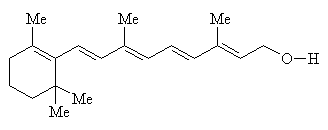
Vitamin A
Structure
Vitamin A is produced from beta carotene in the liver. The 2D carbon chain is shown below:

The 3D structure is shown below (it can be manipulated by moving the mouse over the image with the left button selected):
Function:
Besides being important for normal vision, vitamin A plays a vital role in gene expression, reproduction, embryonic development, growth, and immune function. The Recommended Daily Amount (RDA) of vitamin A for men is 900µg and 700µg for women. The most common symptom of vitamin A deficiency is vision impairment, in particular night blindness, in severe cases total blindness can occur, this generally happens to 500,000 children a year, most of which live in developing countries. According to the World Health Organisation (WHO) many more children die from measles, due to a lowered immune response, caused by vitamin A deficiency. The safe Upper Limit (UL) for vitamin A consumption is 3000µg. Overcomsumption of vitamin A can lead to liver abnormalities in adults, increased risk of physical birth defects and bulging of the skull where the bones have not yet formed in infants.
Mechanism:
Vitamin A is the precursor to 11-cis-retinal, which is a prosthetic group which makes up part of the photosensitive molecule rhodopsin. Rhodopsin is present in the rod cells of the retina, making it sensitive to light.
Sources:
There are many sources of vitamin A, in the form of beta carotene in red, yellow and orange fruit and vegetables. Green leafy vegetables are also a good source. Vitamin A itself can be found in most animal products such as meat and milk, but especially liver.
Fascinating Fact: Eskimos, who hunt for polar bears, don't eat the liver because it is so rich in vitamin A, it's toxic.